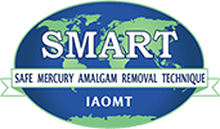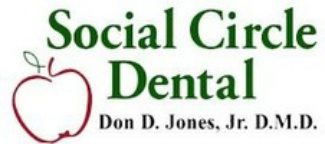 Your dentist is SMART Certified by the IAOMT! Find out more at www.theSMARTchoice.com What is SMART? SMART is the Safe Mercury Amalgam Removal Technique, which is a set of safety measures to reduce mercury exposures during dental amalgam filling removal. These safety measures were developed as a result of scientific research collected by the International Academy of Oral Medicine and Toxicology (IAOMT). Why does SMART matter? All dental amalgams, also referred to as silver fillings, contain 50% mercury (a neurotoxin) which is constantly released in the form of an invisible vapor. The process of drilling out amalgam fillings releases even higher quantities of mercury vapor and fine particulates that can be inhaled and absorbed through the lungs. This is potentially harmful to patients, dentists, other dental workers, and the fetuses of patients and all dental personnel. Which dentists are SMART certified? Dentists who have obtained SMART certification from the IAOMT have completed coursework related to mercury and the safe removal of amalgam fillings. The educational programming includes learning about the application of the rigorous safety measures, including the utilization of specific equipment. To maintain SMART certification, your dentist enrolls in the program annually to review the safety measures. Where can I learn more about SMART? Visit www.smartchoice.com to learn more. Like us on Facebook and share our message with your friends and family so they also make the SMART choice to protect their health! www.theSMARTchoice.com
1 Comment
(COURTESY: The Smart Choice at www.thesmartchoice.com/pregnancy-children-dental-amalgam-mercury-fillings/) Before we address pregnancy, children, and dental amalgam mercury fillings, it should be noted that the IAOMT does not recommend that anyone have amalgam (silver) fillings placed in their mouths because they contain 50% mercury. Mercury is a neurotoxin, and a 2005 World Health Organization (WHO) report identified harmful effects of mercury exposure, including areas of risk specifically linked to mercury in fetuses and children: “Adverse health effects from mercury exposure can be: tremors, impaired vision and hearing, paralysis, insomnia, emotional instability, developmental deficits during fetal development, and attention deficit and developmental delays during childhood.” It is also important to note that as a safety precaution, the IAOMT also does not recommend amalgam mercury filling removal for women who are pregnant or breast-feeding and that the IAOMT does not recommend that dental personnel who are pregnant or breast-feeding conduct work that disrupts amalgam mercury fillings (including their removal). These recommendations are based on scientific research, as well as regulatory actions in some countries. Scientific research about pregnancy, children, and dental amalgam mercury fillings. Research has repeatedly shown the potential for adverse health effects in pregnant women, fetuses, and children as a result of dental amalgam mercury fillings. Some of the impacts that have been examined in science include the following:
Regulations to protect children and women during pregnancy from dental amalgam mercury fillings. Norway banned dental amalgam in 2008, Sweden banned the use of dental amalgam for almost all purposes in 2009, and Denmark, Estonia, Finland, and Italy use it for less than 5% of tooth restorations. Japan and Switzerland have also restricted or almost banned dental amalgam. France has recommended that alternative mercury-free dental materials be used for women during pregnancy, and Austria, Canada, Finland, and Germany have purposely reduced the use of dental amalgam fillings for children, women during pregnancy, and/or in patients with kidney problems. In December of 2016, three EU institutions (the European Parliament, the European Commission and the Council of the European Union) reached a provisional agreement to ban dental amalgam fillings for children under 15 and pregnant and breastfeeding women as of July 1, 2018, and to consider banning dental amalgam completely by 2030. Part of this agreement was inspired by the United Nations Environment Programme’s Minamata Convention on Mercury, which is a global treaty that entered into force in 2017. The United States was the first country to give its support for ratification of the international treaty, which includes initiatives with regards to phasing down the use of dental mercury amalgam. What these measures mean is that some regions of the world are taking action to end the use of dental mercury altogether, while others are at least ending it for children and women during pregnancy as global dental mercury use is slowly phased-down. Yet, dental amalgam mercury fillings are still being used on children and women during pregnancy.
In spite of this treaty and other international legislation, the U.S. Food and Drug Administration (FDA) currently“considers dental amalgam fillings safe for adults and children ages 6 and above.” However, details in the FDA’s public statements about dental mercury amalgam on its website have changed over the years, including information about its potentially harmful impact on women during pregnancy (fetuses) and children under the age of six. Importantly, there are no enforced FDA regulations for this susceptible population or any other population. Due in part to concerns about this lack of protection, the IAOMT filed a lawsuit in 2014 against the FDA over its classification of dental mercury amalgam. As part of the case, the IAOMT secured an internal document from the FDA that had proposed restricting dental mercury amalgam use in pregnant and nursing women and children under the age of six, as well as individuals with mercury allergies and pre-existing kidney or neurological disease. Yet, allegedly for administrative reasons, the FDA communication (dated January 2012) was never released to the public. Meanwhile, as substantial support for ending dental mercury for children and women during pregnancy continues to mount, this toxic filling material is still being used routinely in the US. This is completely contradictory, as it disregards scientific data published in hundreds of peer-reviewed journals and protective measures taken by other countries around the world. Safeguarding American children (and fetuses during pregnancy) from dental mercury has been left to their parents—and the dentists brave enough to warn them about something that the FDA seems to be avoiding. COURTESY: The Smart Choice at www.thesmartchoice.com/pregnancy-children-dental-amalgam-mercury-fillings/ |
AuthorSocial Circle Dental is a holistic dental practice devoted to restoring and enhancing the natural beauty of your smile using conservative, state-of-the-art procedures, while focusing on your overall health and well-being. Archives
May 2024
Categories |





 RSS Feed
RSS Feed